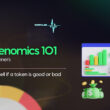Topography is the science that studies the surface of the earth. It is a technique to describe and delineate the surface of a terrain in detail, which includes analyzing the forms of the surface, such as mountains and valleys, as well as the characteristics of rivers and roads, which allows a clear vision of the environment and its ecosystem.
Painting “George Washington, Surveyor”, by Henry Hintermeister (1897-1970).
In this article I propose to describe the surface of the ecosystem of the Cardano blockchain, to have a clearer vision of its direction.
In late 2014, and with the idea of Cardano in mind, Charles Hoskinson and his former Ethereum colleague Jeremy Wood created IOHK (Input Output Hong Kong), a software engineering and research company.
Later, and more than five years ago, on September 23, 2017 at 21:44:51, the Cardano blockchain began its operations, and you can see here the genesis block.
You can read my article on Hoskinson’s motivation (1).
As of the date of writing this article, the blockchain has more than 4.1 million accounts, of which more than 2.2 million have funds, registering more than 67 million transactions throughout its more than 8, 8 million blocks validated in its history.
The participation of 5,614 total stakepools, with 3,197 remaining active to date, have made it possible to write to the ledger, of which 2,926 currently haveLive Stake totaling ₳22.02B, 61% of the circulating supply of ₳35.83B, 79.6% of the scheduled total of ₳45B.
You can see the statistics in AdaStat, or also if you prefer in Cardanoscan or in Cexplorer.
If you want to understand how the Cardano blockchain works, you can read my article that I leave at the end (2).
It is on this structure that the products that make up the Cardano ecosystem are developed. There could be no ecosystem without the input of the developer community, nor could there be a RealFi blockchain without the structure that Cardano provides.
Cardano Proposes A RealFi Blockchain
RealFi is a term that was created in the crypto industry to define developments that provide true DeFi (Decentralized Finance) utility value, beyond speculative investment.
Cardano is proposed as a blockchain on which to build RealFi developments.
Its Proof Of Stake (PoS) design has a philosophy of participation from its root, since unlike Proof Of Work (PoW) where only miners validate the blocks of the network, PoS staking allows holders of their cryptocurrency ADA participate in the registration of transactions in the ledger, choosing stakepools to give it validating power based on the staking they have. At the end I leave an article to understand the differences between both consensus protocols (3).
There are those who criticize its language Plutus is complex to program. Plutus was created by IOHK engineers, and is written in Haskell, which is a Turing-complete functional programming language, providing a secure and complete environment. Others defend the functionality and security of the language as the most suitable for a blockchain that manages money and value. I am not a programmer, but from what I have read from the different opinions, I think that both statements are correct, and perhaps it is worth the effort to learn Plutus, even if it slows down the evolution of the ecosystem, at a steady pace.
I will not present an exhaustive analysis, as I prefer to present a friendly and entertaining read, and not a tedious research document. Observing the surface you can get an initial idea of the terrain. This article invites you to go deeper if you want to go further.
Let’s look at the topography of the ecosystem.
Cardano Topography
IOHK publishes weekly the evolution of the ecosystem, and the latest statistics of the May 26, 2023 registers 127 launched projects, and 1,244 projects under construction, including private and company developments:

Catalyst is a project that finances community developments, voted on by the community, with money from the Cardano Treasury, collected with 20% tax on the rewards of each block and with 20% of the monetary issue.
You can see the statistics of the 9 Catalyst FUNDs on the official site:

Also on LidoNation, a site with very good information:

The website CardanoCube shows a complete and updated list of products developed by various teams, without considering the developments of the blockchain by IOHK.
They are classified by utility, and their slogan is: “Our mission is to make information more accessible by providing an overview of all projects that are built (or being built) on the Cardano Blockchain.”
As of the date of writing this article, there are 605 products, 342 “Utility Projects” (57%) and 263 “NFT Projects” (43%).

Chart based on data from CardanoCube

Chart based on data from CardanoCube
It can be seen that the distribution in number of projects between Utility and NFT is similar. Within the Utility “Community & DAO” predominate (16%), and within the NFT “Collectibles” predominate (25%).
Or 46 Cardano Popular Projects, basing the rating on Analytics, Twitter sentiment, and active partnerships.
The website presents Cardano Graveyard, “A place where we remember the good that failed and the bad that rugged”, which totals 460 projects. Do you remember Ardana?, and BISON COIN?
To understand the DeFi utility, the Total Value Locked (TVL) indicator is generally used, which increased almost 90% in ADA in the last 12 months:

The DEX Minswap has dominance in TVL:

If we analyze the tokens in Cardano, on the TapTools website we can see that the Top 10 tokens by Market Cap, we see that the first two correspond to projects in initial stages, and the third is a meme coin:

On CardanoAssets you can see the Top 10 tokens with the largest number of owners, and the first two are meme coins:

The Top 10 most traded tokens in the last 24 hours is led by a meme coin:

Final Words
In the end, it is the users who set the course of an ecosystem, since they form the market with the demand for products, and only those developments in demand will survive and give the ecosystem its shape.
Each community defines the course based on the different interests, which can change over time, and with the maturation of its members and their ideas.
Collective intelligence is formed with the participation of the diversity of individuals, who interact synergistically in the decision-making market, and which are generally the influences, adopted by the majority, that define the course.
The conclusions, dear reader, are yours, just be attentive and humble in your analysis.
“It takes considerable knowledge just to realize the extent of your own ignorance.” —Thomas Sowell
. . .









